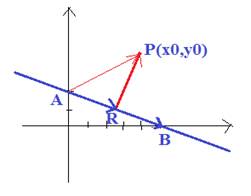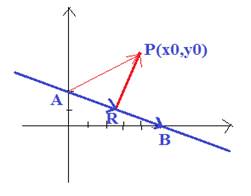
a.
To prove: The given points are the
Given information:
The line equation
Proof:
Let’s substitute the point
Let’s substitute the point
Therefore, the point
b.
To find: The values of
The value of,
Given information:
The line equation
Formula used:
The projection of
Calculation:
Using Head minus Method,
To find
To find
Therefore, the value of
c.
To find: The distance from
The distance from
Given information:
The line equation
Calculation:
A point and a line are separated by a distance that is perpendicular by definition.
Since w2 is parallel to the line L from the point P, it is the distance between P and L.
From part (b), it is known that
Thus,
Therefore, the distance from point to line is
d.
To find: The formula for the distance from any point
The formula to find the distance from point
Given information:
The line equation
Graph:
Considering the point

Interpretation:
From the above graph, writing the vectors of
Now projecting the vector
To find
Now let’s find the distance
Therefore, the distance from point
e.
To find: The formula for the distance from any point
The formula to find the distance from point
Given information:
The line equation
Graph:
Considering the point

Interpretation:
From the above graph, the points
Writing the vectors of
Now projecting the vector
To find
Now let’s find the distance
Therefore, the distance from point
Chapter 6 Solutions
PRECALCULUS:...COMMON CORE ED.-W/ACCESS
- Find the area between the curves. x= -5, x=3, y=2x² +9, y=0 The area between the curves is (Round to the nearest whole number as needed.)arrow_forwardcan you solve these questions with step by step with clear explaination pleasearrow_forwardFind the area between the following curves. x=-1, x=3, y=x-1, and y=0 The area between the curves is (Simplify your answer.)arrow_forward
- Find the area between the curves. x= − 2, x= 3, y=5x, y=x? - 6 6 The area between the curves is (Simplify your answer.) ...arrow_forwardplease question 9arrow_forwardUse the definite integral to find the area between the x-axis and f(x) over the indicated interval. Check first to see if the graph crosses the x-axis in the given interval. 3. f(x) = 4x; [-5,3]arrow_forward
- Use the definite integral to find the area between the x-axis and f(x) over the indicated interval. Check first to see if the graph crosses the x-axis in the given interval. f(x)=3e-4; [3,3]arrow_forwardA small company of science writers found that its rate of profit (in thousands of dollars) after t years of operation is given by P'(t) = (7t + 14) (t² + 4t+7) * (a) Find the total profit in the first four years. (b) Find the profit in the sixth year of operation. (c) What is happening to the annual profit over the long run?arrow_forwardCalculus III May I have an expert explained how the terms were simplified into 6(3-x)^2? Thank you,arrow_forward
- Calculus III May I have an expert explain how the integrand was simplified into the final for form to be integrated with respect to x? Thank you,arrow_forwardCalculus lll May I please have the semicolon statement in the box defined with explanation? Thank you,arrow_forwardCalculus lll May I please have the solutions for the following blank lines? Thank you,arrow_forward
 Calculus: Early TranscendentalsCalculusISBN:9781285741550Author:James StewartPublisher:Cengage Learning
Calculus: Early TranscendentalsCalculusISBN:9781285741550Author:James StewartPublisher:Cengage Learning Thomas' Calculus (14th Edition)CalculusISBN:9780134438986Author:Joel R. Hass, Christopher E. Heil, Maurice D. WeirPublisher:PEARSON
Thomas' Calculus (14th Edition)CalculusISBN:9780134438986Author:Joel R. Hass, Christopher E. Heil, Maurice D. WeirPublisher:PEARSON Calculus: Early Transcendentals (3rd Edition)CalculusISBN:9780134763644Author:William L. Briggs, Lyle Cochran, Bernard Gillett, Eric SchulzPublisher:PEARSON
Calculus: Early Transcendentals (3rd Edition)CalculusISBN:9780134763644Author:William L. Briggs, Lyle Cochran, Bernard Gillett, Eric SchulzPublisher:PEARSON Calculus: Early TranscendentalsCalculusISBN:9781319050740Author:Jon Rogawski, Colin Adams, Robert FranzosaPublisher:W. H. Freeman
Calculus: Early TranscendentalsCalculusISBN:9781319050740Author:Jon Rogawski, Colin Adams, Robert FranzosaPublisher:W. H. Freeman
 Calculus: Early Transcendental FunctionsCalculusISBN:9781337552516Author:Ron Larson, Bruce H. EdwardsPublisher:Cengage Learning
Calculus: Early Transcendental FunctionsCalculusISBN:9781337552516Author:Ron Larson, Bruce H. EdwardsPublisher:Cengage Learning





